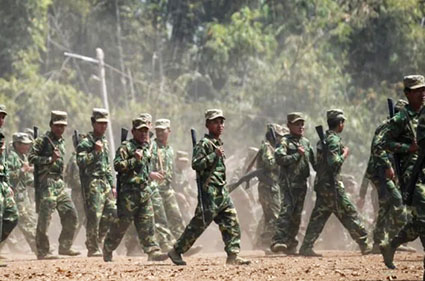Special to WorldTribune.com
 By John J. Metzler, April 14, 2024
By John J. Metzler, April 14, 2024
Burma is no stranger to conflict nor endemic ethnic clashes. Tragically the isolated Southeast Asian state, aka Myanmar, has been in the cross hairs of strife for generations, as a churning cycle of violence creates civil confrontation, refugee exodus, and a widening humanitarian disaster plagues this Texas sized country.
Now three years after the Myanmar military seized power in one of the country’s periodic coup d’état, which toppled a reasonably democratic government, the situation has gone from bad to much worse. And the conflict’s regional spillover has tragically seen more than a million refugees pushed into neighboring Bangladesh.
Since the most recent military coup in 2021, “Some 2.8 million people have been displaced, 90 per cent of them since the military takeover,” advised Lisa Doughten, of the UN’s Office for the Coordination of Humanitarian Affairs. Addressing the UN Security Council she implored, “In 2024, 18.6 million people will need humanitarian assistance across the country…Only an end to the conflict will pave the way for an end to the humanitarian crisis in Myanmar.”
Burma, a resource-rich multi-ethnic state of 55 million people and eight major ethnic groups, has been beset by violence and military rule. Between 1962 and 2011 the Beijing-backed military ruled Burma like a fiefdom; A cautious political opening followed leading to free elections in 2015, which saw the election of longtime pro-democracy leader Aung San Suu Kyi.
Regarding this former British colony, the United Kingdom asserted, “We will not allow Myanmar to become a forgotten crisis.” But has it?
 Myanmar’s military, the powerful Tatmadaw, is supported by both Russia and China. / AFP
Myanmar’s military, the powerful Tatmadaw, is supported by both Russia and China. / AFPThough 88 percent Buddhist, Burma hosts Christian and Muslim minorities, it’s the Rohingya Muslims who face the most recent rounds of persecution.
The troubles revolve around the Rakhine State, the Arakan Army militias often clash with the military. In 2017 Myanmar’s junta initiated large scale ethnic cleansing and evictions of the Muslim Rohingya; more than a million were pushed into neighboring Bangladesh.
This crisis festered even before the most recent military takeover in 2021; but the current problems go beyond the tragic humanitarian crisis inside Myanmar.
Addressing the UN Security Council Assistant Secretary-General Khaled Khiari stated, “Myanmar’s crisis continues to spillover as conflicts in key border areas have weakened transnational security and the breakdown in the rule of law has allowed illicit economies to thrive.” He warned, “Myanmar has become a global epicenter of methamphetamine and opium production, along with a rapid expansion of global cyber-scam operations.”
Equally Khiari remarked that fighting between the Myanmar military and the Arakan Army forces has reached “an unprecedented level of violence.”
U.S. Deputy Ambassador Robert Wood followed up on the growing threat to international security, “Myanmar has become the world’s largest opium producer, a hub for transnational organized crime, and a driver of several major refugee crises.”
As importantly he stated, “In the past five months, Myanmar’s military carried out 588 airstrikes across the country, with such attacks on civilians increasing five-fold.”
Recently UN Secretary-General Antonio Guterres appointed former Australian foreign minister Julie Bishop as his new envoy for Myanmar and to hopefully revive the moribund peace process.
Hopefully along with ASEAN, the UN will renew its peace efforts for Myanmar.
Myanmar’s military, the powerful Tatmadaw, is supported by both Russia and China. Moscow’s UN delegate expressed regret that holding an open meeting on Myanmar prevents the Council from “having a tranquil non-politicized discussion focused on seeking solutions to the problems.” China, long the political patron to the Burmese junta added, “the conflict in Rakhine State is Myanmar’s internal affair. As a friendly neighbor of that country, China has continued to promote peace and dialogue.”
Beijing has pressured the “Brotherhood Alliance” of three ethnic armies not to attack Chinese interests. Interestingly Beijing moves aim at sponsoring some sort of peace deal between various Myanmar militants and the central government as to smooth the path for Belt and Road (BRI) expansion.
Burma shares a long border with China; both illicit border trade and official commerce thrive.
Currently a Chinese delegation is visiting Myanmar to carry out communication and mediation efforts on the Rakhine situation. Through Beijing’s BRI initiative, Myanmar is closely linked to China; the Junta and Beijing officials are developing a special economic zone and deep-sea port project in western Rakhine at Kyaukphyu which allows China’s landlocked Yunnan province access to the Indian Ocean. China already has oil and gas pipelines running to the Bay of Bengal.
Will China’s geo-strategic moves outflank India and the U.S. in the Indo- Pacific region?
John J. Metzler is a United Nations correspondent covering diplomatic and defense issues. He is the author of Divided Dynamism the Diplomacy of Separated Nations: Germany, Korea, China (2014). [See pre-2011 Archives]
Source link

